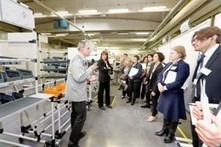Mar 31 2014
Working outside in rather than inside out | Bill Waddell
See on Scoop.it – lean manufacturing
“Perhaps one of the most inane – but very typical – aspects of the business process in manufacturers is the construction of the supply chain from the inside out. Three times in the last week – count ‘em – three for three – I visited a manufacturing company with (1) problems delivering in the time frame customers want; (2) lots of inventory but rarely the right inventory; and (3) a supply chain constructed by their supply chain people based on some idea of how to construct a supply chain but not one constructed based on a delivery objective.
In other words, some factory guys got together at some point – probably with an accountant or two breathing down their necks and decided this is how we purchase and this is how we schedule production and that is the resulting lead time, so sales …. Go out and try to shove those lead times down customers’ throats, regardless of what customers want or need….”
See on www.idatix.com




Apr 1 2014
Steve Jobs on Juran | Curious Cat | John Hunter
See on Scoop.it – lean manufacturing
“This webcast shows an interesting interview with Steve Jobs when he was with NeXT computer. He discusses quality, business and the experience of working with Dr. Juran at NeXT computer. The video is likely from around 1991.”
The interview starts slowly, with Jobs collecting his thoughts before speaking, and it was not supposed to be about Juran. Jobs is the one who brings up Juran in response to a question about quality.
At first, he reverently calls him “Dr. Juran” — Juran was not a PhD — and then, affectionately, “Joe Juran.” Steve Jobs as the respectful disciple is something I had not seen before. What was he so impressed with? Here are a few I picked up in the video:
Towards the end of the video, the 30-year old Jobs sounds more and more as if he setting a role model for himself. But Juran lived to be 103; Jobs died at 56, only three years after Juran, and did not get the chance.
See on management.curiouscatblog.net
Share this:
Like this:
By Michel Baudin • Blog clippings 0 • Tags: Jobs, Juran, Quality